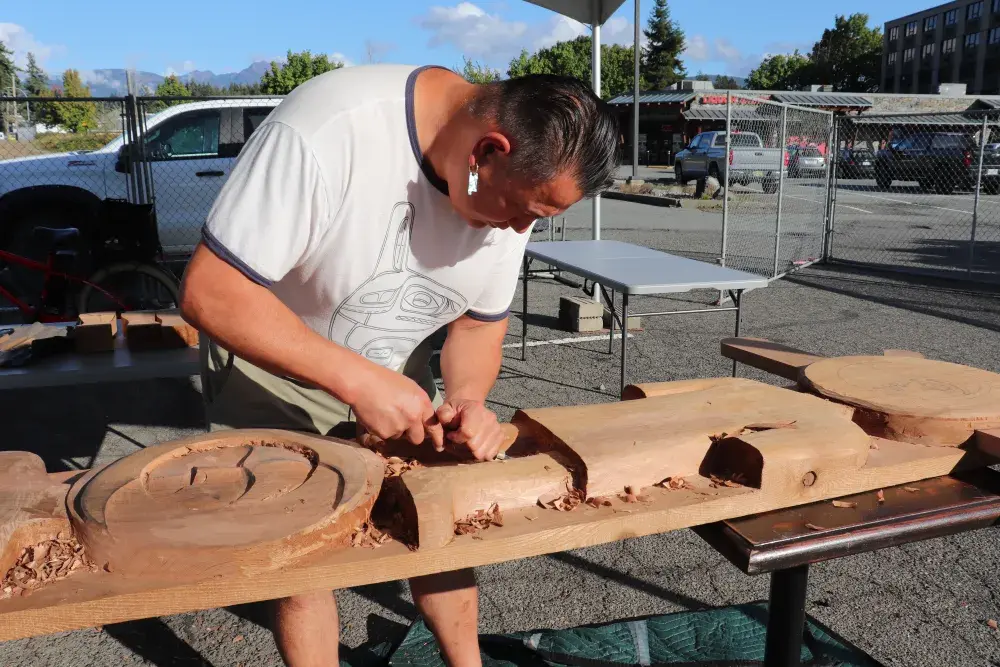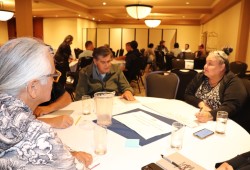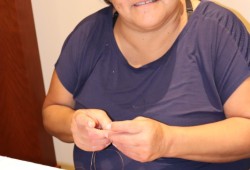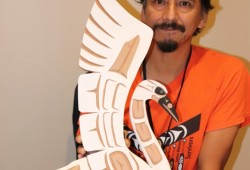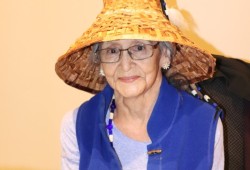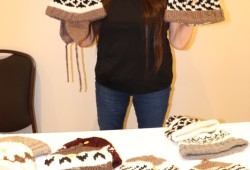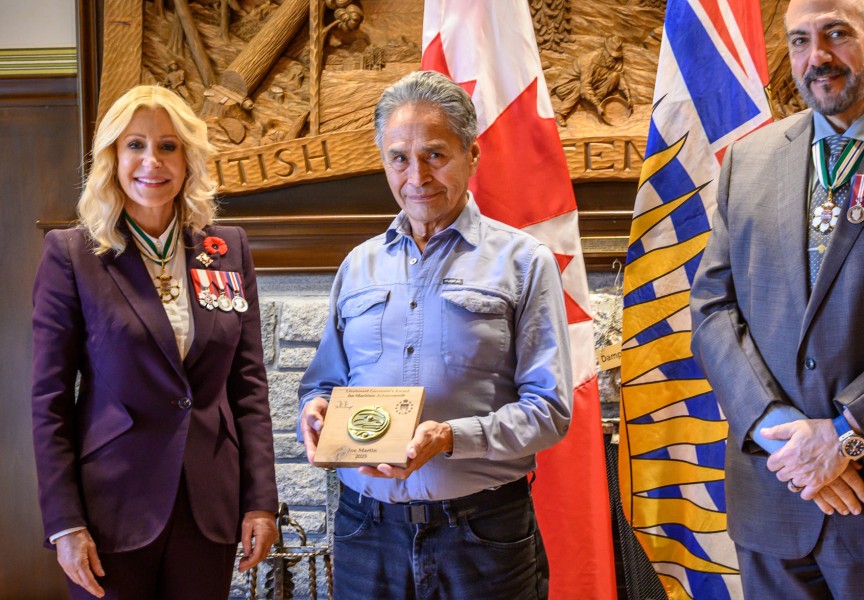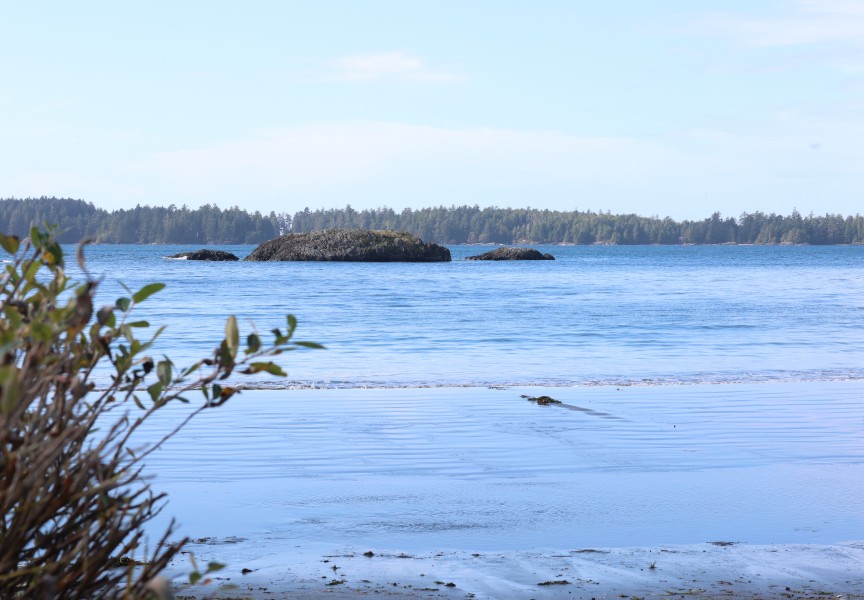A group of Nuu-chah-nulth master artists gathered at the Best Western Barclay hotel in Port Alberni at the invitation of Huu-ay-aht First Nations. According to organizer Kimmie McDonald, this is the first-ever Indigenous artist symposium held in Port Alberni and she hopes it won’t be the last.
Huu-ay-aht master carver Edward Johnson Sr. told the group of artists that when he first arrived, he wasn’t even sure what a symposium was, but toward the end of the second day, he said he understood and thought it was beneficial for Nuu-chah-nulth artists.
By definition, a symposium is a conference in which experts or academics discuss a particular subject.
In this case, about a dozen Nuu-chah-nulth master artists discussed important topics around art and showcasing their work. They spent September 12 and 13 at the hotel in group discussions and engaged in other activities.
The artists discussed ways in which they can protect their art from being exploited or stolen. They also discussed what forms of art should be held sacred and private, and what can be shared with the public. They talked about ways in which mentorship can be provided to up-and-coming artists.
In March 2023, then-project-lead Edward Johnson Jr. told Ha-Shilth-Sa that the idea for the symposium was part of a plan to bring Huu-ay-aht citizens back home and to put a spotlight on Indigenous artists. They applied for and received funding from the Canada Council for the Arts to host the symposium.
“Our aim is to create an artists’ collective to collaborate on tourism/culture development strategy and build a space that displays traditional ways of creating art with modern access,” Johnson Jr. wrote in an email to Ha-Shilth-Sa.
He went on to say that a collective would advocate to protect the artists’ rights and the authenticity of Indigenous creative pieces.
“We want to have true Indigenous artists enabled and on display,” he continued. “With a space dedicated to Indigenous art, we can control our own stories, push boundaries and preserve art in the face of loss of language.”
Over the course of discussions at the symposium, artists shared who they learned from and cultural teachings they picked up along the way.
Lavern Williams, a weaver from Huu-ay-aht, shared how she learned from her grandmother how to harvest grasses and bark for weaving. She recalled fighting the biting bugs as she harvested. Her grandmother told her to crush a certain plant in her hands and rub the liquid over her skin to keep the bugs away.
“She was a pretty cool gramma – she always wanted to teach me something new,” said Williams of her grandmother Carrie Mickey.
Many of the carvers recalled spending time in carving sheds, mentored by master carvers. They acknowledged that it is a good way to draw the interest of up-and-coming artists.
“We set up a carving table in the parking lot outside the hotel for 20 minutes and it wasn’t long before people were dropping by to watch Tim (Paul) carve,” said Hjalmer Wenstob.
Wenstob, a Tla-o-qui-aht artist, has been working on totem poles and sculptures that are being erected in his homeland. His goal is to one day see more than 200 poles in the territory, like it used to be. He brought one of his projects to the symposium and allowed other carvers to work on the pole.
Wenstob said he dreams of a Nuu-chah-nulth cultural education centre, but it would have to be reimagined from the historical context.
“Old teachings were that when artists worked on projects, the community took care of them, they would feed them,” he said. “When they were taken care of the artists could concentrate 100 percent on their art. We don’t have that anymore.”
Feeling guilt and the responsibility to give back, Wenstob told the crowd that he wants to mentor young artists but he doesn’t have the time. This is something people want, noted Wenstob, but it costs money to have a space and, in this day and age, most artists have other jobs.
“We still have to feed the family and pay the bills,” he said.
He suggested that a Nuu-chah-nulth cultural education center could operate with a rotating schedule of master artists.
“People can be learning under Gordon Dick, Tim Paul, Joe Martin, Hipolite Williams and others,” he said.
Hupacasath artist Rod Sayers asked if they should have a Nuu-chah-nulth centre for the arts and if so, what it would look like. Everything takes money, he noted.
“All wealth is generated from the land, yet we have to ask for permission to get a log in our own territory,” he said.
Hesquiaht carver Tim Paul concurred. Even with the benefit of major donors there are always regulations and guidelines to follow – money with strings attached.
Paul asked that a cultural library be set up. He talked about his peers, those with cultural knowledge, entering their 80s. He spoke of art projects involving family stories and from residential school survivors.
“We don’t own it (stories) – it has to go back to the families,” said Paul.
But with governments funding projects, “we have to be responsive to the templates of Indian Affairs – that’s how we’re losing our culture,” said Paul.
“We have to get something done now,” he stressed.
The Huu-ay-aht organizers hope that the outcomes from this event will support another Nuu-chah-nulth artists symposium in 2024.
Nuu-chah-nulth master artists taking part in the symposium were Edward Johnson Sr., Hipolite Williams, Lavern Williams, Gerren Williams, Tom Patterson, Tim Paul, Connie Watts, Geraldine Edgar-Tom, Gordon Dick, Hjalmer Wenstob, and Rodney Sayers.

